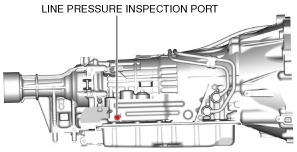 |
MECHANICAL SYSTEM TEST [SJ6A-EL]
id051311249100
Mechanical System Test Preparation
1. Apply the parking brake firmly, and set the wheel blocks for both the front and rear wheels.
2. Inspect the engine coolant level. (See ENGINE COOLANT LEVEL INSPECTION [SKYACTIV-G 1.5, SKYACTIV-G 2.0].)
3. Inspect the engine oil level. (See ENGINE OIL LEVEL INSPECTION [SKYACTIV-G 1.5, SKYACTIV-G 2.0].)
4. Inspect the ATF level. (See AUTOMATIC TRANSMISSION FLUID (ATF) LEVEL ADJUSTMENT [SJ6A-EL].)
5. Inspect the idle speed. (See ENGINE TUNE-UP [SKYACTIV-G 1.5, SKYACTIV-G 2.0].)
6. Inspect the ignition timing. (See ENGINE TUNE-UP [SKYACTIV-G 1.5, SKYACTIV-G 2.0].)
Line Pressure Test
1. Perform mechanical system test preparation. (See Mechanical System Test Preparation.)
2. Remove the test plug and O-ring from the line pressure inspection port.
amxuuw00003499
|
3. Install SSTs (49 D019 908, 49 D019 909, 49 D019 910, 49 D019 911, 49 D019 913) to the line pressure inspection port as shown in the figure.
ardjjw00004897
|
4. Start the engine and warm it up until the ATF reaches 60—70 °C {140—158 °F}.
5. Shift the selector lever to the D position.
6. Measure the line pressure while idling in D position.
7. Measure the line pressures while idling in the M (1st gear) and R positions using the same procedure.
8. Stop the engine.
9. Change the low-pressure gauge (49 D019 908) to the high-pressure gauge (49 D019 907).
ardjjw00004898
|
10. Start the engine.
11. Strongly depress the brake pedal with the left foot.
12. Shift the selector lever to the D position.
13. Slowly depress the accelerator pedal fully with the right foot all the way down.
14. Read the line pressure quickly while stalling, and remove the right foot from the accelerator pedal.
15. Shift the selector lever to the N position and idle for 1 min or more.
16. Measure the line pressure while stalling for positions other than D in the same procedure.
|
Condition |
Possible cause |
|---|---|
|
Higher in R, D, and M (1GR) position
|
• Line pressure control solenoid malfunction
• Primary regulator valve malfunction
|
|
Lower in R, D, and M (1GR) position
|
• Line pressure control solenoid malfunction
• Primary regulator valve malfunction
• Oil pump malfunction
|
|
Lower in D position
|
• Hydraulic circuit of D malfunction
• C1 clutch malfunction
|
|
Lower in R position
|
• Hydraulic circuit of R malfunction
• C3 clutch malfunction
• B4 brake malfunction
|
Line pressure (SKYACTIV-G 1.5)
|
Measurement conditions |
Specification (kPa {kgf/cm2, psi}) |
|
|---|---|---|
|
D and M (1GR) position
|
Idle
|
350—430 {3.57—4.38, 50.8—62.3}
|
|
Stall
|
860—1040 {8.77—10.60, 125.0—150.8}
|
|
|
R position
|
Idle
|
760—950 {7.75—9.68, 111—137}
|
|
Stall
|
1410—1630 {14.38—16.62, 204.6—236.4}
|
|
Line pressure (SKYACTIV-G 2.0)
|
Measurement conditions |
Specification (kPa {kgf/cm2, psi}) |
|
|---|---|---|
|
D and M (1GR) position
|
Idle
|
350—430 {3.57—4.38, 50.8—62.3}
|
|
Stall
|
900—1080 {9.18—11.01, 131.0—156.6}
|
|
|
R position
|
Idle
|
760—950 {7.75—9.68, 111—137}
|
|
Stall
|
1410—1630 {14.38—16.62, 204.6—236.4}
|
|
17. Remove the SSTs.
18. Install the test plug and O-ring in the inspection port.
Stall Speed Test
1. Perform mechanical system test preparation. (See Mechanical System Test Preparation.)
2. Start the engine.
3. Strongly depress the brake pedal with the left foot.
4. Shift the selector lever to the D position.
5. Slowly depress the accelerator pedal fully with the right foot all the way down.
6. Read the engine speed quickly when the speed is stabilized, and remove the right foot from the accelerator pedal.
7. Shift the selector lever to the N position and idle for 1 min or more.
8. Measure the stall speed in the M (1st gear) and R positions using the same procedure.
|
Condition |
Possible cause |
|---|---|
|
Lower in R, D, and M (1GR) position
|
• Engine lack of power
• Torque converter one-way clutch malfunction
|
|
Higher in D and M (1GR) position
|
• Insufficient line pressure
• C1 clutch malfunction (slippage)
• F3 one-way clutch malfunction
|
|
Higher in R position
|
• Insufficient line pressure
• B4 brake malfunction (slippage)
• C3 clutch malfunction (slippage)
• F1 one-way clutch malfunction
|
|
Higher in R, D, and M (1GR) position
|
• Insufficient line pressure
• Oil leakage from each position circuit
|
Engine stall speed (SKYACTIV-G 1.5)
|
Measurement conditions |
Specification (rpm) |
|---|---|
|
D, R, M
|
2,158—2,458
|
Engine stall speed (SKYACTIV-G 2.0)
|
Measurement conditions |
Specification (rpm) |
|---|---|
|
D, R, M
|
2,546—2,846
|
Time Lag Test
1. Perform mechanical system test preparation. (See Mechanical System Test Preparation.)
2. Start the engine.
3. Shift the selector lever from the N position to the D position with the brake pedal depressed.
4. Measure the time until the shift shock is felt firmly after shifting.
5. Measure the time lag from the N position to the R position using the same procedure.
|
Condition |
Possible Cause |
|---|---|
|
N → D shift
|
• Insufficient line pressure
• C1 clutch malfunction (slippage)
• F3 one-way clutch malfunction
|
|
N → R shift
|
• Insufficient line pressure
• C1 clutch malfunction (slippage)
• C3 clutch malfunction (slippage)
• F1 one-way clutch malfunction
|
Time lag
|
Measurement conditions |
Specification (s) |
|---|---|
|
N position → D position
|
0.7 or less
|
|
N position → R position
|
1.2 or less
|